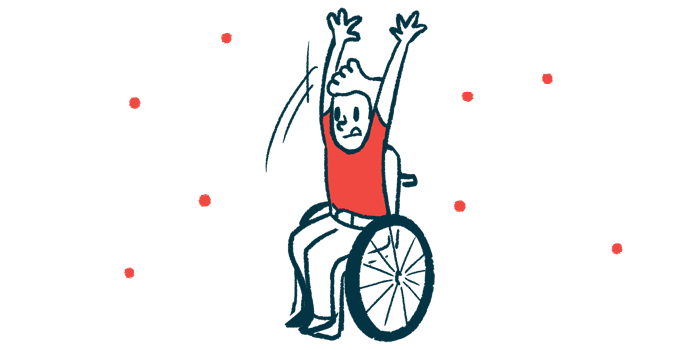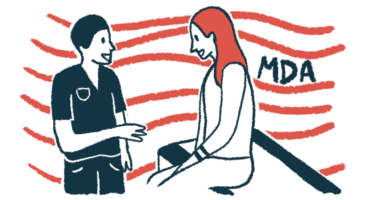Measuring arms’ nerve activity may help predict response to Evrysdi
CMAP values taken before, nearly one year after starting treatment

Measuring the electrical activity of a pair of nerves that control arm movement, called the median nerves, could help assess how people with spinal muscular atrophy (SMA) respond to Evrysdi (risdiplam).
That’s according to “Evaluation of risdiplam efficacy in 5q spinal muscular atrophy: A systematic comparison of electrophysiologic with clinical outcome measures,” which was published in the European Journal of Neurology.
Evrysdi is an oral therapy widely approved to treat SMA. It boosts production of the SMN protein whose defect causes the disease.
While clinical trials have shown Evrysdi can substantially slow SMA’s progression, some people may respond better or worse to the therapy. There’s no well-validated way to predict how well patients will respond to Evrysdi or other SMA treatments, leading researchers in Germany to study if measuring compound muscle action potential (CMAP) could evaluate the response to treatment.
The CMAP can record the combined electrical signals produced by all the individual muscle fibers that work together when the muscle is activated. In SMA, symptoms arise due to the death and dysfunction of the nerves responsible for controlling movement.
“Biomarkers appropriate to measure, monitor, or even predict the response to disease-modifying drugs such as [Evrysdi] are still lacking to date … CMAP recordings might be useful to objectively monitor clinical courses in SMA patients and assess responses to available pharmacotherapies including [Evrysdi],” wrote the researchers.
Measuring nerve activity in arm, leg movement
The study included 18 adults with SMA types 2 or 3 who were treated with Evrysdi at their center. The patients ranged in age from 18 to 69 and slightly more than half were female. Two were able to walk and seven could sit up independently. The other nine could not sit up independently.
CMAP values for several major nerves in the arms and legs were measured before starting Evrysdi, and then again after nearly a year of taking it. The patients underwent several standardized assessments of motor function, including the Hammersmith Functional Motor Scale-Expanded (HFMSE), the Revised Upper Limb Module (RULM), and Children’s Hospital of Philadelphia Infant Test of Neuromuscular Disorders (CHOP INTEND).
CMAP values tended to gradually worsen over months of follow-up among the patients with data available before they started Evrysdi. Functional measures either got worse or didn’t change during the untreated follow-up.
Of the 18 patients who received treatment, seven were deemed “responders” to Evrysdi, as they showed notable improvements on the HFMSE and/or RULM. Overall motor scores tended to improve after treatment, with statistically significant improvements seen in average HFMSE and CHOP INTEND scores.
Increase in CMAP value observed with Evrysdi
The average CMAP value in the medial nerves — a set of nerves important for controlling the movement of the arms — increased significantly with Evrysdi. Before treatment, the average CMAP value for both the right and left medial nerves was 7.2 millivolts (mV). After 10 months on Evrysdi, the average CMAP on both sides increased by more than 1 mV.
“The first 10 months of treatment with [Evrysdi] led to a robust increase in CMAP amplitudes of both median nerves,” the researchers wrote, noting the increase “was paralleled by improvement of well-established clinical scores” like HFMSE and CHOP INTEND.
CMAP values of other nerves in the arms and legs generally didn’t show noteworthy changes with treatment. This wasn’t unexpected, the researchers said, since most of the patients couldn’t walk and had “highly degenerated lower limb motor neuron function and muscle wasting.”
The patients with a higher median nerve CMAP when they started treatment were more likely to see improvements in functional measures after 10 months on Evrysdi, further statistical analysis indicated. This is consistent with research that shows SMA treatments like Evrysdi tend to result in more dramatic benefits for patients with less advanced disease who retain more motor nerve function.
“Our results suggest that CMAP recordings of the median nerve could be more meaningful for assessing and monitoring treatment effects, and that this should be considered in future clinical investigations,” said the scientists, who noted more research was needed to validate their findings and to test whether median nerve CMAP might help predict the response to other SMA treatments. “Median nerve CMAP should be further assessed in larger cohorts as a potential electrophysiologic biomarker that is widely available, patient-friendly, and easy to use in the application of disease-modifying pharmacotherapies for SMA.”
Evrysdi is sold by Roche, which was not involved in the study. It was funded in part by the German Society for Muscle Diseases.








